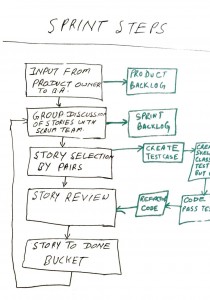SapientNitro
We were commissioned to apply creative climate techniques to quickly build a team preparing a multi million pound bid on behalf of SapientNitro.
The project was geared to assembling a team to present a bid for a global telecommunications company. This first involved showing the team how the associated Agile approach works and providing them with confidence to carry out two-hour one-on-one practical sessions with the client organisation.
The project was very short – two weeks – with the Agile ‘sprints’ compressed into daily sessions.
The examples of various team activities provides an insight into the softer side of Agile Development; putting people first allowed the climate measurement tools to generate rapid buy-in to a fast-paced learning process.
Meet the Team
We had a culturally diverse team preparing a bid for a multinational telecoms client. The team consisted of two Product Owners, two Scrum Masters, two QAs, two Testers and two Developers. If you’re not immediately familiar with these roles, don’t worry – you’re welcome to look up the relevant Agile terminology, but it’s not essential to the story.
This is us having a “chatacino”. It was fun to get out of the office and have the occasional extended stand-up meeting at the coffee shop.
The following sections will look at climate, planning, communication, measurement and retrospectives – and the lessons we learned from the whole exercise.
Shared Mental Models
Comscientia joined the project with most of the team already in place. On Day One we were introduced to the processes of the company and quietly observed what was happening in the team. It was quickly evident that there were some sharply opposed viewpoints among team-members.
To ascertain the different viewpoints in the team we facilitated a Magazine Cover session.
The results below show the most different productions. The first was produced by a pair of developers, and the second by the Product Owners.
 |
 |
With the team now aware that there were varied viewpoints of what we were trying to achieve we had a group vote in what aspects of the learning process they wanted to improve. Rather than kick off a potentially divisive debate about the merits of one point of view over the other we carried out a climate survey.
Climate
The team was new; most people had not worked together before. In this case the question is: “What type of climate do you want?”. We restricted the number of votes per member to focus what they consider their top priorities. A simple flip-chart listing the Climate parameters was set up and the team dot-voted on an ideal climate.
In this case the team wanted trust and openness, challenge and playfulness with dynamism and idea support. We took time to discuss the votes and find examples of specific actions the team would like. In short, they wanted pair-work with different functional members. This informed the techniques and methods used during the training to break out of an office bound mentality.
Communication
The next day we facilitated a ‘Blind Man Walking’ session with the functional pairs split. This was the turning point in the communication level in the team. Here is a Product Owner being led by a developer.
Admittedly, not everyone immediately took to the ice breaker approach; two members blind-walked out for a coffee instead!
In general, the closer the members were to the business (Product Owners and QAs), the more they enjoyed the sessions. The developers found them a little abstract and did not always enjoy being moved out of their comfort zones (see lessons learned below).
The dividends were reaped during the ‘code dojos’. The increased level of communication made the more hesitant and introspective team members realise that they could contribute to the debates that developed during the dojo.
Measurement and visibility
All teams need to be able to see the progress – and importantly so does the business. We used a Scrum wall that was updated daily to show tasks moving from the backlog through the phases of work until they were complete.
Retrospectives
Each ‘sprint’ should have a retrospective to generate and share lessons learned; we have seen retrospectives range from an hour to a day in duration, but we find the shorter ones more productive.
Here is a retrospective we facilitated in action, using divergent and convergent techniques
The teams produced force-field and fishbone diagrams to create contrasting viewpoints of various topics that had cropped up during the sprint. It was the first time that the majority of the team had used such diagrams. This focused the dialogue and debate with ‘warm’ actions rather than plodding through the same stuffy agenda-and-minutes processes. They enjoyed the experience.
The retrospective led to another block vote to decide on the topics to address.
This is an example of a self-organising team using double-loop learning to alter its environment, with added benefits in terms of morale and productivity.
Lessons learned
- Not everybody enjoys being moved out of their comfort zones. Leadership requires knowing how far individuals can be pushed and when and why to do it.
- Ice breaker activities lead to better communication – usually.
- ‘Code dojos’ transfer know-how and are enjoyable.
- Group normative techniques are extremely useful to include and involve more introverted team members.
- The realisation of self-organisation is best achieved through double-loop learning where the team can alter its environment by changing variables it controls but may not know exist.
So What?
Some people laughed at some of the methods we employed. The client, however, was impressed enough at the outcomes to offer repeat business. Sometimes, that’s all the feedback you need.









